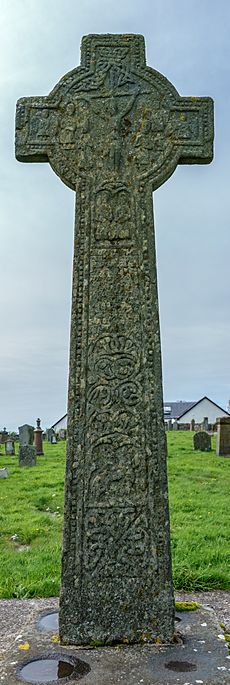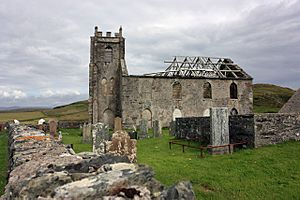Kilchoman facts for kids
Kilchoman is a small village and a large area (called a parish) on the Scottish island of Islay. It's part of the Argyll and Bute council area. The name "Kilchoman" comes from a Scottish Gaelic name, which sounds like "keel-KHOM-en."
Contents
About the Village
The village of Kilchoman has a few houses built around a church from the 1800s. It is located near the sandy beach and dunes of Machir Bay, which people also call Kilchoman Beach.
This area has a very long history, going back to the early days of Christianity in Scotland. The church you see today was built in 1827. It was made for a large community that has since become much smaller. The church stopped being used for worship in 1977. Before 1827, a medieval church stood in the same spot, and even before that, there was an early chapel.
The churchyard around the ruined church has many old stone carvings. You can see a famous tall stone cross there, called the Kilchoman Cross. It was made in the 1300s or 1400s by an artist from the Iona School.
Kilchoman Military Cemetery
Close to the village, there is another cemetery called the Kilchoman Military Cemetery. The Commonwealth War Graves Commission takes care of it. This cemetery is where victims from the sinking of HMS Otranto are buried. This ship sank in 1918 during World War I.
Wildlife Around Kilchoman
A special bird called the Chough lives and breeds in the farmland near Kilchoman. They also live on the south shores of Loch Gorm. About 10% of all the Choughs in the British Isles live in this area. Choughs are a vulnerable bird species, meaning their numbers are not very high.
A short distance to the east of the village, you will find the Kilchoman Distillery.
The Parish of Kilchoman
The parish of Kilchoman is a large area that covers the western part of Islay. It includes the Rhinns of Islay and the land around and north of Loch Gorm. To the east, it is bordered by Loch Gruinart and Loch Indaal. The entire parish is about 100 square miles (250 square kilometers).
This large area includes several other small villages and settlements. Some of these are Ardnave, Bruichladdich, Claddach, Conisby, Kilchiaran, Kilnave, Nerabus, Port Charlotte, Portnahaven, and Port Wemyss.
See also
 In Spanish: Kilchoman para niños
In Spanish: Kilchoman para niños




